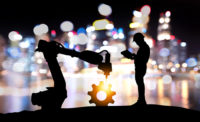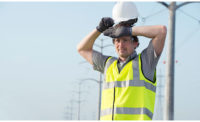This month, ISHN interviews Ted Smith, founder and CEO of Corvex, a software and mobile safety device manufacturer based in Eden Prairie, MN.
Is digital transformation on the manufacturing floor — regarding safety and health specifically — a foregone conclusion?
It comes down to the value proposition. Safety pros would love to use the latest technology, but their budgets have been fixed for years, and their budgets have never included technology. This needs to change. Safety uptake of technology is limited from an ROI perspective because injury rates are so low. For safety, the argument is why spend $10,000-15,000 on wearables when you don’t have that much of a problem. It’s the operations folks who have money to invest.
Do you see drivers that will speed up safety’s uptake of Industry 4.0 technology?
Quality, productivity and safety have all plateaued. They are all stuck with good numbers. The piece they are missing is worker engagement. Millennials want to be engaged, want to be heard. Older workers just want to fix things. So you have this clash. Older workers are not tech savvy and sit with their arms crossed. Engaged younger workers are more apt to drive trials.
Millions of manufacturing workers are in their 50s and 60s. Do they want technology data and devices?
Older workers have seen a lot of programs thrown at them over the years. There is skepticism of another program. Technology engagement devices have to be incredibly easy to use to counter this.
How do you overcome resistance that being a “connected worker” means being watched by big brother?
We identify the behavior, not the person. With a lot of smart PPE, slapping a sensor on a worker does not encourage engagement. Workers in effect are walking sensors. They know more about a job, and technology gives them another means to communicate their knowledge. Emphasize the benefits of being “connected.”
What is real-time messaging?
Factory floor workers often can’t have personal cell phones. Using our mobile device, people can communicate with each other. They can develop shift notes for the next shift. You can’t simply say workers can’t have data. These folks all need data. We use an Android device, a company-issued phone. It’s an app. You can use it like a walkie-talkie. Location sensing indicates what zone workers are in. You can push content to them, and get content from them from their observations.
What are location-specific triggered events?
If you walk into an area with open hazards, you would be notified by the mobile device. In a hazard zone, you can get notification that presents data about those hazards and how to work safely.
Describe risk tolerance profiles.
A number of factors go into these profiles. If you have high-risk individuals in high-risk environments, you can send out content so the connected worker can be made aware more of the risks. There is a certain behavioral economics here. We’re building behavioral nudges with technology. Nudging workers to be more aware.
Describe crowd-sourced safety risk management.
Say I’m a new age worker, a younger worker; I go out on floor, I see something but don’t know how to fix it. I escalate this observation using a mobile device to find someone, often an older worker, who can fix the problem. The person who created the observation is always in the loop. They see the end result of their observation — the fix. The next time they can resolve a problem themselves. This is crowd sourcing using older and younger workers.
When will smart PPE become standard PPE?
Smart PPE that solves specific safety issues will succeed, such as heat management, heat stress, ergonomics, and noise. Things that are very specific. The challenge that all smart PPE companies must solve is this: you can’t create something where workers become complacent. It’s easy to get complacent when you hear beeping all the time.
Smart PPE can’t be something that is just stuck on worker. It must create awareness, say of heat management. If you have a heat index sensor measuring where they are, if they have been there for more than an hour, here are some precautions for you. You can do the same with lifting. After a certain number of lifts, a worker get pinged and alerted that here are some things to learn.
Smart PPE requires engagement — enabling workers to be part of a company instead of simply being present at company. Safety folks love our stuff. We are looking to expand into other areas. Quality has same inspections as safety. If a product is broken, tech allows you to trace the problem back to its roots. It’s all about technology expanding engagement. And this will happen in a number of fields.



